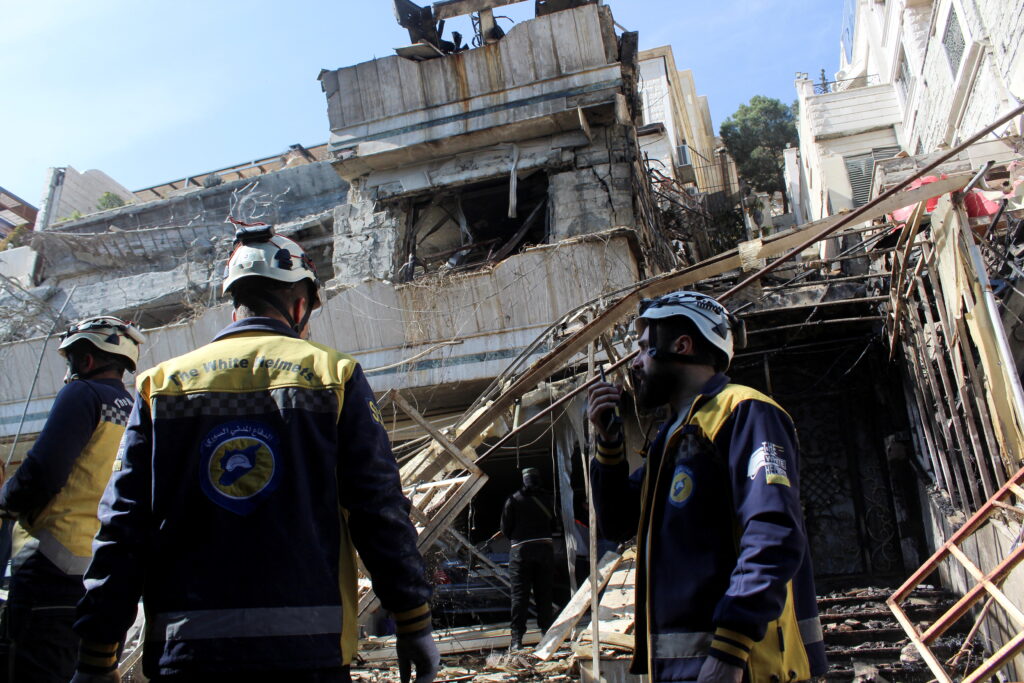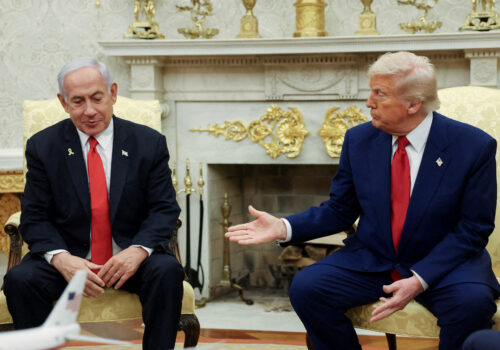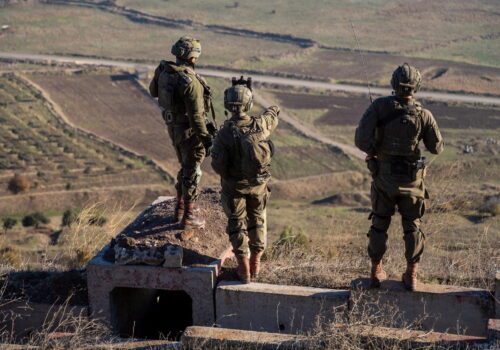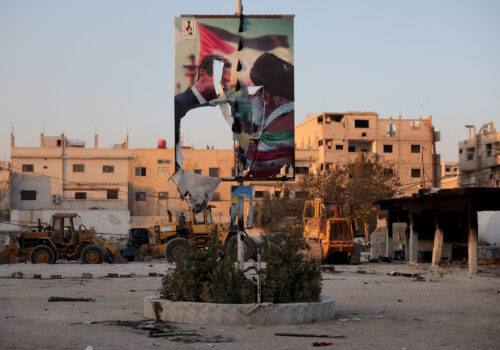Lebanon’s 1982 war reverberates in Israel’s Syria campaign
In the early hours of December 8, 2024, Israeli warplanes launched a wave of precision strikes across southern Syria, marking the start of what Prime Minister Benjamin Netanyahu would later describe as a necessary preventive campaign aimed at “avoiding another October 7 scenario.”
At first glance, the ongoing Israeli intervention in Syria appears fundamentally different from Israel’s 1982 invasion of Lebanon. Israel’s Operation Peace for Galilee in 1982 was fundamentally reactive, while its stated motives today in Syria are largely preventative.
Yet, beneath the surface, the parallels are striking and warrant careful consideration to anticipate the long-term implications of Israel’s latest regional military venture. Reflecting upon Israel’s 1982 military venture in Lebanon offers essential insights for shaping its current strategy in Syria. Indeed, Israeli policymakers must reconsider their current path, shifting from a purely military-centric approach toward a more nuanced strategy combining diplomatic foresight, restraint, and targeted political engagement.
Preventive versus reactive war
Israel launched its 1982 invasion of southern Lebanon in response to escalating rocket and guerrilla attacks by the Palestine Liberation Organization (PLO) against Israeli territory. This direct threat provided Israel a clear justification for military action, aiming explicitly to disrupt and dismantle the operational bases from which the PLO was attacking.
In Syria today, no factions have recently launched cross-border attacks against Israel, nor have local military actors significantly threatened Israeli territory from Syrian soil. Yet Netanyahu’s administration justifies its ongoing campaign by highlighting the risk posed by abandoned military assets left by Bashar al-Assad’s collapsed regime, arsenals potentially accessible to the current Syrian caretaker government led by Hay’at Tahrir al-Sham (HTS). Thus, the strategic calculus behind Israel’s intervention aims to eliminate perceived future threats, project military strength, and proactively establish strategic depth.
SIGN UP FOR THIS WEEK IN THE MIDEAST NEWSLETTER
The acquisition and control of strategic territorial assets represent another similarity between Israel’s past actions in Lebanon and its current operations in Syria, and the distinction between a preventive versus a reactive strategic calculus is blurred. In 1982, Israel sought control of key military and geographic assets such as Beaufort Castle, from where rocket attacks were previously launched, and the Litani River, a natural boundary enhancing its defensive position. Israel intended to create a buffer zone to insulate its northern territory from future aggression, ultimately holding southern Lebanon for nearly eighteen years before withdrawing under sustained pressure from Hezbollah.
Similarly, today, Israel is asserting its dominance over the demilitarized zones established under the 1974 ceasefire agreement and over the Syrian side of Mount Hermon, critical for its strategic oversight of Damascus. This high terrain offers invaluable surveillance advantages, enabling early detection of threats deep within Syrian territory. Given this strategic value, it is difficult to imagine Israel relinquishing control over such a significant asset without immense international or domestic pressures, a scenario reminiscent of southern Lebanon.

Yet, substantial differences exist between the operations, notably regarding military engagement. Israel’s 1982 invasion was primarily ground-based, characterized by intense urban warfare and heavy casualties, with 670 Israeli soldiers lost. Israel today enjoys unrivaled air superiority over Syrian airspace. This advantage allows the Israeli Air Force to neutralize any targets swiftly and precisely, avoiding direct engagement and minimizing casualties. Consequently, Israel currently operates with considerable strategic flexibility, unpressured by immediate military confrontation.
However, it is essential to note that Israel’s deliberate containment of its military engagement reflects a calculated choice rather than necessity. It currently faces no pressing ground threats within Syria that could justify escalation. This approach explains Israel’s adamant opposition to any significant redeployment of Syrian military forces or allied militias in Daraa, Suweida, and Quneitra. Any significant shift on the ground could force Israel into a more direct, costly ground campaign, fundamentally altering its military doctrine in Syria.
The challenge of allies and local dynamics
A critical dimension of Israel’s military intervention in Lebanon in the eighties was its alignment with local factions—namely, its support of Maronite Christians. This was exemplified by its backing of Bashir Gemayel’s presidential bid and the creation of proxy militias, such as the South Lebanon Army (SLA). However, Lebanon’s fragmented sectarian environment proved to be significantly more intricate than initially anticipated. The assassination of Bashir Gemayel highlighted the inherent risks and unintended consequences associated with Israel’s local alliances in adversary environments and serves as a cautionary example of the potential pitfalls Israel faces when pursuing similar alignments in Syria. Israel has engaged with the Druze community in southwestern Syria, aiming to establish a strategic buffer against potential threats. Yet, this policy has inadvertently heightened the vulnerability of the Druze community and notably contributed to perceptions of the group as a national adversary.
By contrast, Syria’s sectarian dynamics are more nuanced and resistant to such simplification. Although sectarian identities remain influential, the fragmentation and internal complexities within communities such as the Druze and Sunni populations complicate Israel’s attempts at forming reliable proxy relationships. While the Druze community of southern Syria, for example, is central to Israel’s declared narrative of protecting minorities, deep internal divisions render any potential alignment with Israel highly controversial and internally divisive.
Unlike in Lebanon, where Palestinians constituted an external and universally opposed actor within specific communities, Israel’s supposed adversaries in Syria represent indigenous social forces deeply embedded in the country’s fabric. Therefore, any sectarian or communal proxy strategy risks amplifying internal Syrian tensions without providing Israel a stable, long-term security advantage.
Another central feature of Israel’s 1982 Lebanon invasion was the clearly defined regional rivalry with Syria, which at the time acted as the primary regional opponent supporting Lebanese factions hostile to Israel. Syrian influence, bolstered indirectly by Iranian and Soviet backing, significantly impacted Israel’s strategic calculations, turning southern Lebanon into a complex geopolitical battleground.
Simultaneously, Iran’s role in post-Assad Syria today, although diminished, remains an essential factor to consider. Israel and Iran, despite deep-seated antagonism, paradoxically share an interest in preventing the consolidation of a centralized, Islamist-led government in Damascus. For Israel, the fear revolves around a potential “October 7” scenario, while for Iran, the objective is to maintain enough influence through instability to prevent a complete regional realignment toward Sunni-majority states such as Turkey and the Gulf. This overlapping interest inadvertently risks reviving Iranian influence in a chaotic, fragmented Syrian landscape, repeating precisely the scenario Israel aims to avoid.
The Turkey factor
While the direct Iranian military threat in Syria has significantly receded post-Assad, a new and perhaps more formidable actor has emerged, Turkey.
Unlike Syria’s indirect and often proxy-driven engagement in Lebanon, Turkey possesses advanced NATO-standard military capabilities, political sophistication, and clear strategic objectives aiming at regional leadership rather than mere disruption.
Crucially, Turkey’s policy contrasts sharply with the role Syria historically played in Lebanon. Syria aimed to weaken the Lebanese central authority, foster fragmentation, and exert dominance through local proxies. Turkey, conversely, has consistently supported efforts toward state centralization and governance restoration in post-Assad Syria, irrespective of the ruling faction. Ankara’s involvement focuses not on fostering factionalism but rather on strengthening the institutional and territorial integrity of the Syrian state, seeking stability rather than chaos. This difference significantly reshapes Israel’s strategic landscape.
Nevertheless, despite aiming to seek stability, the Turkish approach still presents complex geopolitical challenges for Israel. Ankara’s increased presence and potential influence in southern Syria could gradually complicate Israel’s air operations or limit its freedom of maneuver. Yet, notably, Turkey has so far avoided direct confrontation or escalation with Israel, favoring cautious diplomacy. This signals that while Israel must manage its military intervention carefully, Ankara’s current policy posture suggests that Turkish-Israeli relations will remain tense yet controlled, characterized more by rivalry than open conflict.
Long-term implications and historical lessons
First and foremost, Israel should approach its involvement in southern Syria with extreme caution regarding any form of prolonged military presence. History has shown repeatedly that indefinite occupation, even if initially limited, creates conditions ripe for resentment, insurgency, and protracted instability.
Despite the undeniable short-term military and intelligence advantages gained from occupying strategic territories, the Israeli presence risks gradually transforming from a stabilizing factor into a source of enduring hostility. This scenario mirrors precisely the Israeli experience in southern Lebanon, where the extended occupation cultivated resentment among the local population, ultimately empowering militant factions such as Hezbollah, who capitalized on Israel’s strategic vulnerabilities.
Indeed, Israel’s long-term security interests are better served by allowing the establishment of a stable government in Syria, even if led by factions or entities ideologically distinct from its traditional preferences. The emergence of coherent, accountable authorities capable of providing basic governance and security is paramount to preventing the re-emergence of violent extremism and cross-border threats. Although politically challenging, Israel must acknowledge that sustained stability and security along its northern frontier hinge significantly on Syria’s internal coherence rather than on Israeli military dominance alone. This shift requires a pragmatic willingness to tolerate credible governance frameworks in Syria that can effectively secure territory and limit extremist influence. Israel should militarily disengage and instead work through diplomatic initiatives and a credible peace-making process.
Moreover, effective stabilization in Syria demands comprehensive diplomatic coordination with regional and international stakeholders—primarily Turkey, Saudi Arabia, Qatar, the United States, and European allies. Historically, Israel has often preferred unilateral action or limited coordination, believing it more directly serves its immediate security concerns. However, this narrow approach risks isolating Israel diplomatically and escalating unintended regional tensions. A cooperative regional diplomatic strategy can create a favorable geopolitical environment and align regional stakeholders behind common objectives of stability.
Such a strategy could involve Israel engaging discreetly with regional counterparts through informal track II diplomacy dialogues mediated by neutral third parties, notably leveraging its strategic relationship with the United States. Despite existing geopolitical competition, engaging proactively with Turkey is especially critical given Ankara’s growing regional influence and significant military capabilities. Specifically, Israel could initiate security-focused talks with Turkey through US-brokered dialogues to manage mutual security concerns, establish protocols to prevent unintended military escalations, and explore shared interests in limiting Iranian influence and extremist threats.
Another crucial dimension of Israel’s strategic recalibration involves carefully managing Syria’s sectarian and communal landscape. Israel must avoid the temptation to exploit sectarian divisions, as these efforts invariably foster internal conflicts and deepen societal fragmentation. Attempts to manipulate these internal divisions may provide short-term tactical advantages but will likely yield adverse long-term consequences, undermining regional security and stability. Instead, Israeli policymakers should adopt a policy of cautious neutrality toward sectarian dynamics rather than fueling further communal polarization.
Finally, Israel must grapple proactively with the underlying geopolitical threat of a potential Iranian resurgence within Syria, particularly in scenarios characterized by chronic instability. The historical experience in Lebanon vividly illustrates how a perceived power vacuum, often exacerbated by military intervention, can be skillfully exploited by external actors like Iran. Therefore, Israel’s strategic posture must include diplomatic initiatives to reduce the conditions that could enable Iranian influence to grow indirectly in Syria.
Direct military deterrence against Iranian proxies is necessary but insufficient. Instead, Israel could support multilateral frameworks involving the United States, Europe, and Arab states to negotiate mechanisms that restrict the flow of funds and arms to Iranian-backed militias in Syria. Additionally, Israel could advocate for targeted international sanctions explicitly aimed at Iranian entities involved in destabilizing activities within Syria, rather than broader sanctions affecting civilians. Such policies would help curtail Iran’s regional influence without exacerbating humanitarian crises or fueling further instability.
Ultimately, Israeli policymakers face a critical strategic choice in Syria, informed by historical lessons from Lebanon’s troubled legacy. Reliance primarily on military solutions has historically produced limited and often counterproductive results. Conversely, a strategy that incorporates comprehensive diplomatic engagement and nuanced political maneuvering has far greater potential for establishing lasting stability and enhancing Israel’s long-term security interests. Israel now stands at a pivotal juncture, either repeating past strategic missteps or boldly charting a more measured course.
Sinan Hatahet is a nonresident senior fellow for the Syria Project in the Atlantic Council’s Middle East Programs and the vice president for investment and social impact at the Syrian Forum.
Further reading
Mon, May 19, 2025
Could Trump be ‘mediator-in-chief’ for Turkey and Israel in Syria?
MENASource By
If Trump wants to achieve the Middle East's “deal of a century," its important that Netanyahu and Erdogan resolve their differences in Syria.
Tue, Apr 1, 2025
Israel is making a miscalculation in southern Syria. Here is why.
MENASource By Ömer Özkizilcik
Israel’s approach in southern Syria risks deepening sectarian divisions, eroding the Druze community’s standin, and fueling broader instability.
Thu, May 8, 2025
From rubble to rebirth: A model for Syria’s reconstruction
MENASource By
Almost six months since Assad regime collapse, four key pillars will determine whether this new Damascus can seize the opportunity.
Image: A Palestinian fighter is posted near a DCA on the Corniche. His eyes are fixed on the sky and a possible enemy raid. Lebanon, Beirut - July - 1982. Un combattant palestinien est poste pres d’une DCA sur la Corniche. Il a les yeux fixes vers le ciel et un eventuel raid ennemi. Liban, Beyrouth - Juillet - 1982.NO USE FRANCE



